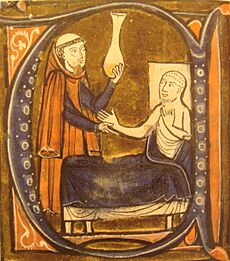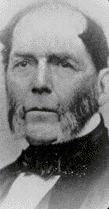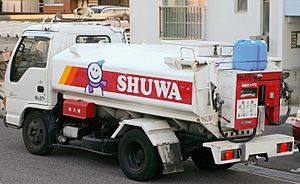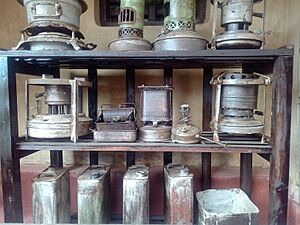Kerosene facts for kids
Kerosene, also known as paraffin, is a clear liquid that burns easily. It's made from petroleum (crude oil) and is used as a fuel for many things, like jet engines and lamps. The name "kerosene" comes from a Greek word meaning "wax." It was first a brand name but is now a common word for this fuel.
Kerosene powers jet engines in airplanes and even some rocket engines in a very pure form called RP-1. People also use it for cooking and lighting, especially in many parts of the world. Some small boat engines and even motorcycles in Asia use kerosene. A lot of kerosene is used every day around the world.
Different places call it different names. In countries like the United States, Canada, and India, it's usually called "kerosene." But in the United Kingdom, South Africa, and Norway, it's called "paraffin." Sometimes it's also called "lamp oil."
It's important not to confuse kerosene with gasoline (petrol), which is much more flammable. To help prevent mistakes, some places require kerosene containers to be a specific color, like blue in Pennsylvania, USA.
The World Health Organization says that burning kerosene in homes can be bad for your health. The smoke from kerosene can cause breathing problems and other illnesses. Because of this, they suggest that people stop using it for cooking and lighting inside their homes.
Contents
What is Kerosene Like?
Kerosene is a clear, thin liquid. It's made from crude oil by heating it up and collecting the parts that turn into liquid at certain temperatures. It has a density of about 0.78 to 0.81 grams per cubic centimeter, which means it's lighter than water. Kerosene mixes with other oil-based liquids but not with water.
It's made of tiny molecules that mostly contain 9 to 16 carbon atoms. These molecules are mainly straight or branched chains of carbon and hydrogen.
Kerosene burns with a lot of energy, similar to diesel fuel. This is why it's a good fuel.
There are different types, or "grades," of kerosene. For example, in the United States, there are 1-K and 2-K grades. 1-K kerosene has less sulfur and burns cleaner, so it's better for indoor heaters. In the United Kingdom, there are also different grades for different uses, like lanterns or home heating.
How Cold or Hot Does Kerosene Get?
Kerosene is a liquid at normal room temperature. It can catch fire if it gets hot enough, usually between 37°C (99°F) and 65°C (149°F). This is called its flash point. It will start to burn on its own at about 220°C (428°F).
Kerosene can freeze if it gets very cold. The temperature at which it freezes depends on the type, but aviation fuel, for example, is designed to stay liquid down to about -47°C (-53°F).
Kerosene's Story

The idea of taking crude oil and separating it into different parts, like kerosene, goes way back. A Persian scholar named Rāzi wrote about it in the 800s. He described how to make a clear, safe-to-burn liquid from oil using a special device. People in China also used petroleum for lighting and heating as early as 1500 BC.
Making Lamp Oil from Coal and Oil Shale
For a long time, people used whale oil to light lamps indoors because it burned brightly and cleanly. But in the 1700s, chemists knew about "coal oil," which was a byproduct of making coal gas. However, it burned with a lot of smoke, so it wasn't good for indoor lamps.
In 1846, a Canadian geologist named Abraham Pineo Gesner showed a new way to make a clear lamp fuel. He heated coal and collected the liquid that came out. He called this new fuel "kerosene," which meant "wax-oil." Making kerosene from coal was expensive.
Around the same time, in 1848, a Scottish chemist named James Young also started experimenting with oil from coal. He found a way to make useful liquids, including one he called "paraffine oil." He got patents for his process in the 1850s and built the first commercial oil factory in the world in Scotland.
Kerosene from Crude Oil
In 1851, Samuel Martin Kier in the United States started selling "Carbon Oil" for lamps. He made it by distilling crude oil. He even invented a new lamp to burn his product.
A Polish pharmacist named Ignacy Łukasiewicz also worked on improving how to distill oil. In 1853, doctors at a hospital needed bright light for an emergency operation. They used Łukasiewicz's new lamps, which burned very brightly and cleanly. This showed everyone how useful his invention was. He then started a refinery in Poland.
In 1859, Edwin Drake discovered a lot of oil in Pennsylvania, USA. This led to many new oil wells being drilled in the US, Canada, and Poland. With so much crude oil available, it became easier and cheaper to make lamp oil from petroleum instead of coal. This new petroleum-based lamp oil was widely sold as "Kerosene." Soon, the name "kerosene" became a common word for this type of fuel.
As kerosene production grew, the demand for whale oil dropped a lot. The whaling industry, which had been very big, started to shrink quickly. Kerosene had taken over the market for lamp oil.
Later, in the late 1800s, electric lighting started to become popular, especially in cities. This meant less kerosene was needed for lamps. However, kerosene still found new uses, like in stoves and portable heaters.
Kerosene from Carbon Dioxide and Water
Recently, in July 2022, scientists at ETH Zurich used solar power to make kerosene from carbon dioxide and water. This new type of kerosene can be used in airplanes and can even be mixed with regular kerosene.
How Kerosene is Made
Kerosene is made in an oil refinery. Crude oil is heated in a tall tower. As it heats up, different parts of the oil turn into vapor and then cool down at different levels in the tower. Kerosene is collected at a temperature between diesel fuel (which is heavier) and gasoline (which is lighter).
In 2021, kerosene made up about 8.5% of the products made in US oil refineries. Most of this was used as jet fuel.
What Kerosene is Used For
Heating and Lighting
Kerosene is still widely used in kerosene lamps and lanterns, especially in developing countries where electricity might not be available. In the past, kerosene lamps could be dangerous if the kerosene was mixed with other, more flammable liquids. In 1880, many fires in New York City were caused by faulty kerosene lamps.
In many less-developed countries, kerosene is an important fuel for cooking and lighting. Backpackers also use it in portable stoves. It's often used as a heat source during power outages.
In countries like Japan and Chile, kerosene is a common fuel for home heaters. You can buy it at gas stations or sometimes have it delivered to your home. In the United Kingdom and Ireland, kerosene is used for heating homes that are not connected to natural gas pipelines.
Some groups, like the Amish, who don't use electricity, rely on kerosene for lighting at night. Farmers used to use kerosene-fueled "smudge pots" to protect crops from freezing. Kerosene heaters called "salamanders" are used on construction sites to dry materials and keep workers warm.
A special type of kerosene lamp uses a gas mantle. This mantle glows brightly when heated by the flame, giving off a much better light than a simple wick lamp. These lamps are still used today in places without electricity.
Cooking
In countries like Nigeria, kerosene is a main fuel for cooking, especially for people who can't afford other fuels. Because of this, changes in kerosene prices can have a big impact. The Indian government even helps pay for kerosene to keep its price low, so people don't cut down forests for cooking fuel.
Kerosene is also used in portable stoves, like the Primus stove invented in 1892. These stoves are reliable and work well in cold weather or at high altitudes, making them popular for outdoor activities and mountaineering.
Engines
In the early to mid-1900s, kerosene was a cheap fuel for tractors and other engines. Some engines were designed to start on gasoline and then switch to kerosene once they warmed up.
After World War II, some cars in Europe were changed to run on kerosene because gasoline was expensive. More recently, between 1980 and 1984, some cars were made in Finland that could run on kerosene or turpentine to save on fuel taxes.
Today, kerosene is mainly used as jet fuel for airplanes. A very pure form called RP-1 is used as rocket fuel when mixed with liquid oxygen. For example, the powerful Saturn V rocket that took astronauts to the Moon used RP-1 as its fuel.
Kerosene is sometimes added to diesel fuel in cold weather to stop it from getting too thick or "gelling."
The New York City Transit Authority uses a special type of kerosene for its bus fleet. The US military also uses a kerosene-based fuel called JP-8 for its aircraft, vehicles, and heaters.
Other Uses
Kerosene can be used as a solvent to clean things. It can remove sticky residue from stickers on glass or clean old grease from bicycle chains. Some artists even use it to thin oil-based paint or clean their brushes.
In X-ray crystallography, kerosene can be used to store crystals and protect them from drying out. It can also store certain metals like potassium and sodium because they react with air and water.
Kerosene and Safety
The World Health Organization warns that using kerosene in homes is harmful. The smoke from burning kerosene contains tiny particles that can cause serious health problems, including breathing issues, cancer, and eye problems.
It is very dangerous to swallow kerosene. Some people have used kerosene as a folk remedy for head lice, but health experts strongly advise against this. It can cause burns, serious illness, and even be fatal if the fumes are inhaled.
People who work with kerosene should be careful. They can be exposed by breathing it in, swallowing it, or getting it on their skin or in their eyes. Safety guidelines recommend limits for how much kerosene vapor people can be exposed to in the workplace.
See also
 In Spanish: Queroseno para niños
In Spanish: Queroseno para niños





